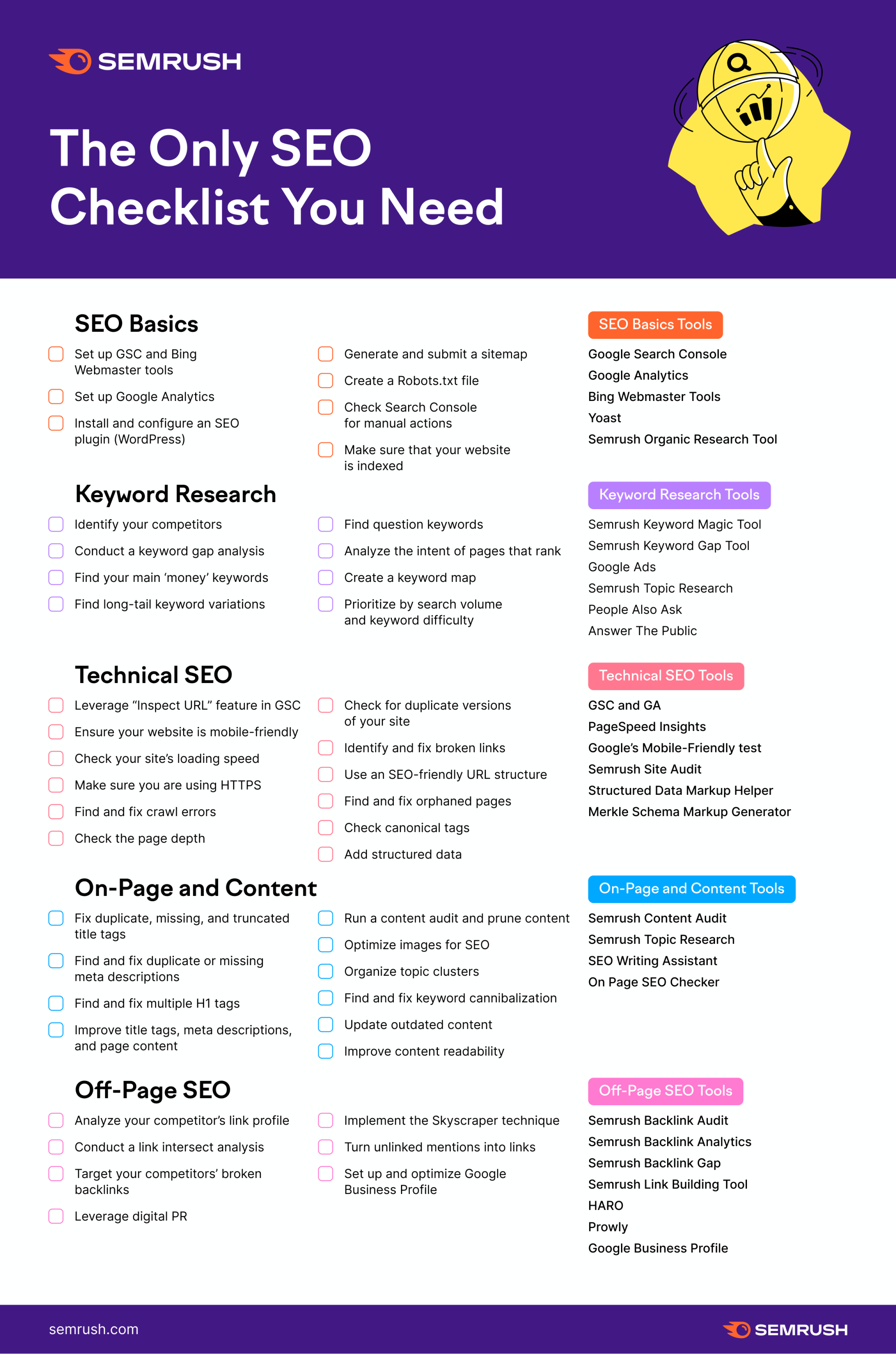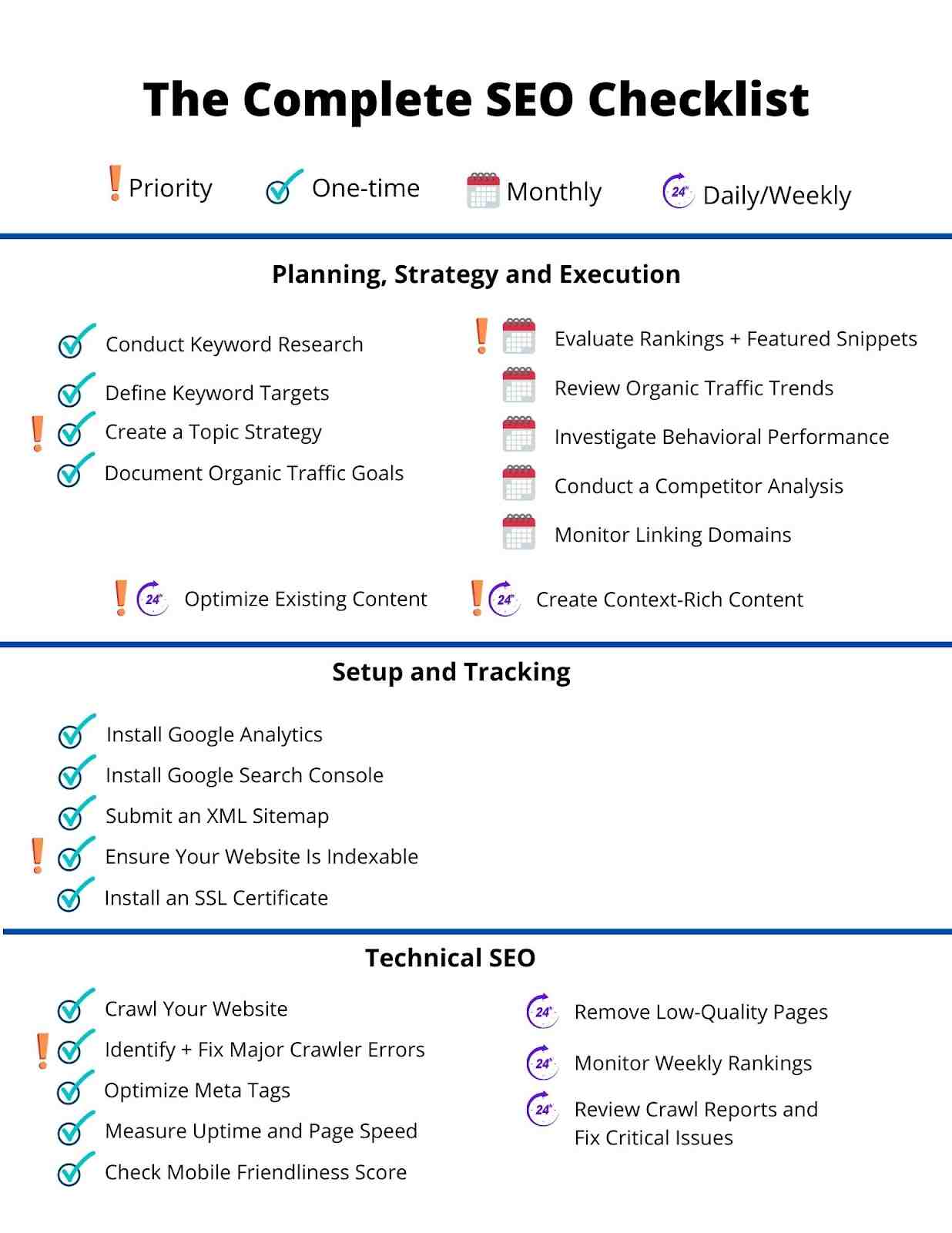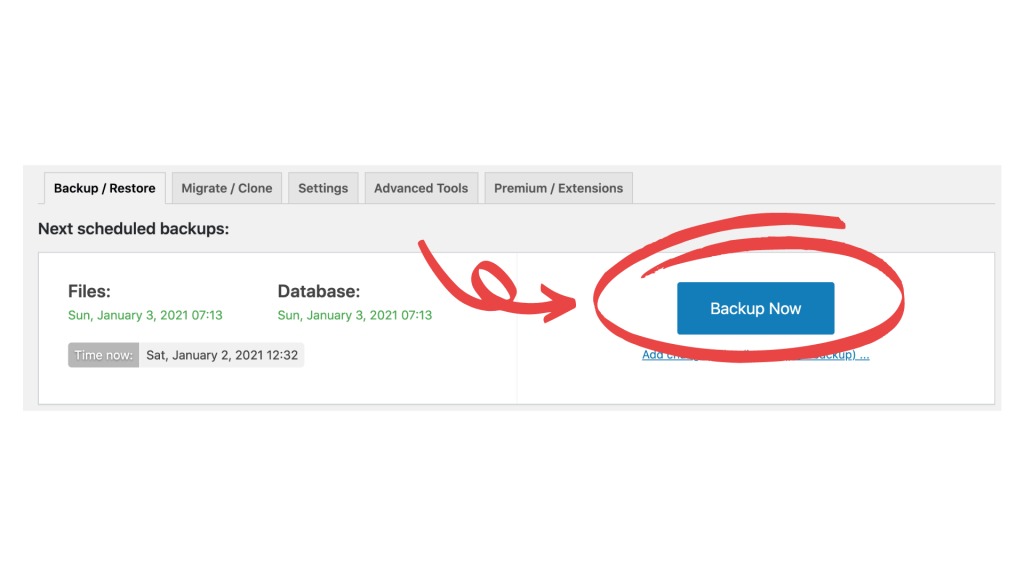SEO is a great discipline. Without structure and planning, a lot of time and money can be lost or used inefficiently.
A lot of SEO activities are started and never finished.
Couple that with the fact that SEO is never “done,” and it can be difficult to start, end, and stay on track with priority strategic and tactical elements that have a chance to make a real impact.
By dividing SEO into daily, monthly, quarterly and annual steps and process-driven tactics, you can build the right level of planning to keep track and effective.
These activities should be linked to goals and a larger strategy, but offer a great framework for how to ensure that SEO is well planned and structured on an annual basis.
Daily
Contents

Educate Yourself
Staying up to date on industry news is a critical aspect of SEO that needs to be integrated into every ongoing maintenance or management plan.
This ranges from mission critical alerts and updates that search engines are committed to keeping tabs on SEO best practices and the latest news from sources like Search Engine Journal.
The big changes in the industry are hard to miss.
But smaller, more subtle changes can be magnified when they are missing or best practices become obsolete.
Don’t leave behind or implement obsolete tactics!
Know Your Current Metrics
Monitoring your key SEO performance metrics in real time, or at least once a day, is especially necessary for brands and companies that rely on e-commerce transactions or lead volume to feed a team. for sale.
Knowing how your website works in search through top-level metrics is important to recognizing any red flags. These could include:
Being able to recognize problems as they happen is key.
You need to be able to diagnose problems and reverse any negative trends before they have an impact on your overall marketing and business goals.
By keeping tabs on current performance, you can compare benchmarks and basics to make sure you fully understand the cause and effect with your metrics and don’t have a problem for too long before you can intervene.
You can monitor less critical KPIs (any of which do not require an immediate reaction) on a weekly basis.
Make Progress On Tactics
A solid SEO plan or campaign should have specific goals, strategy, and tactics outlined.
Without a defined plan, process, or approach, you can waste a lot of time pursuing specific aspects of SEO that may have a low impact and low priority.
The daily process should include specific tasks, steps, and reasonable actions that work toward the bigger picture.
Tactics may include things being done for the first time in a phased approach or action items that are more in a rinsing and repeating methodology.
Regardless, the list of specific technical action items, on-page and off-page should be defined by the year, broken down into months, and more into tactics and progress that can be made each day to stay in shape. track.
SEO requires great press thinking and the ability to handle everyday tasks and action articles.
Monthly

Report On Performance
Beyond daily or weekly KPI monitoring, it is often important to use monthly cycles to more broadly report performance.
The emphasis on monthly checkpoints allows for dedicated time to compare a larger sample size of data and see trends.
The monthly performance report should include year-on-year comparisons of the full month plus any available statistics to date.
Find meaningful intervals to measure and be consistent. Looking at larger time intervals helps to see trends that are difficult to decipher in small sample sizes.
Any stories of what and why for deviations in scope, goals for exceeding goals, and metrics that ensure possible changes to the plan are critical to the surface and prioritized through a dashboard or snapshot report of performance data.
Recap Completed & Continuing Action Items
This is a chance to evaluate the tactics and execution in the previous month against the plan.
Looking to the past helps shape the future.
When you combine action articles and tactics with performance data, you should get an overview of the reality of what drives SEO performance.
Plan Next Month’s Action Items & Evaluate The Plan
The monthly intervals are large to ensure responsibility for the completion of the works.
Even when the year is planned, things change in SEO, and performance isn’t always what we expect after doing something the first time.
By taking a monthly planning approach, adjustments can be made to the plan such as doubling a specific tactic or adjusting the overall strategy to recalibrate.
By being agile enough to monthly assess performance and tactics, you can avoid thinking excessively about things and reacting too quickly, but don’t let too much time go by and lose your footing with trends toward goals.
Having a good balance of planned tactics and actions versus the need for agile methods to pivot when needed is often the best approach to staying current and proactive.
Quarterly

Technical Issues Auditing
Assuming you’ve covered technical issues at the beginning of your SEO focus and are also looking for anyone who activates red flags in your daily and weekly monitoring, it’s important to take a broader look through a quarterly audit.
This audit should include a review of the issues reported in the Google Search Console and Bing Webmaster Tools.
In addition, comparisons to benchmarks and standards for site speed, mobile usability, validation of structured data, and appearance are not often looked at on a more frequent basis.
On-Page Issues Auditing
Without an audit process and even with frequent monitoring, things happen on websites.
A code update, database update, plugin / extension update, or publishing content can cause duplicate tags, duplicate content, or even missing elements on the page.
A quarterly audit of on-page problems that can be performed using a wide range of free and submitted third-party tools is important.
There are tools that will also send alerts and factors in the daily process if something changes like a meta description that is deleted.
Regardless, having a stack of solid tools and processes for quarterly assessment and comparison with the previous audit is important to ensure that audit results and any necessary corrections are noted and made in the tactical plan.
Link Profile Auditing
The SEO plan in general probably includes some form of link building.
Whether it’s to find links with engaging content or a more focused plan of research and outreach, it’s probably part of the tactics underway (or should be considered, if it’s not).
Investing time and effort in tactics makes it important to have visibility into the overall profile of the link and progress.
This could be a performance metric tracked in the monthly reporting phase, but quarterly needs to be audited in a deeper sense.
Assessing the quality of links, the number of links, the diversity of sources, the relevance of linked content, comparisons to competitors, comparisons to benchmarks, and period-by-period comparisons are all important aspects to ensure that the plan is carried out as provided in the backlinks area.
In addition, if it isn’t caught up in daily or monthly efforts, any spammy links or negative SEO attempts can be caught here and addressed through the disavow process.
Local Listings Audit
Once the management of local lists is in maintenance mode, there will be no frequent need for major changes with NAP data (name, address, telephone) or inconsistencies in list data.
However, this does not mean that it does not happen and that it can be “set and forgotten”.
An audit using third-party tools to ensure the accuracy and consistency of the data is strongly recommended at least quarterly.
This audit can identify issues that may be addressed on a one-time basis, and also provide guidance on performance and any necessary changes to the content, reviews, and other aspects of the same in addition to the NAP database.
If any data sources or third-party listings are missing, the Google Business Profile data may be overwritten with inaccurate listing information.
Even if it doesn’t change anything with your list management, the data can change and should be monitored to a minimum.
Yearly

Measure Performance
When executing annual plans for SEO – and even when they are not on annual agreements or evaluation cycles – taking a whole year of data and evaluating it is helpful to advise on strategy and find measurable ROI calculations.
SEO is a long process to get the most competitive positioning possible in the search engines. It is a valuable investment of time to keep performance data on 12-month intervals, compare with previous periods, look at benchmarks and celebrate successes.
Even if you don’t have an annual budget or agreement with external partners / suppliers, taking a year step back and looking at performance and effort as an investment instead of an expense is important.
Planning Strategy & Tactics
In addition to reviewing annual performance data, you should also plan your goals, strategies, and tactics for the coming year.
Even if the plan could change a week in maintenance, having a plan, and setting a goal is a key to measuring progress.
Without a plan and using past learning and a realistic view of the resources invested in the year to come, there can be a gap between expectations and reality.
It is best to resolve this before taking months on the road.
Conclusion

We all have specific goals and results that we want to achieve from our investments and SEO efforts.
Rather than reacting and putting in the things that scream the loudest, having a structure and organization for how the work is done can keep your time and investment focused.
Whether it’s technical factors, on the page, content, or backlinks, having an established cadence and structure in your approach can balance the two planned activities and maintain the agility needed to react in the moment.
And make sure that progress is made and priorities for SEO work do not get out of balance.
Image presented: Besjunior / Shuttertstock
An SEO niche is part of a large market in which you intend to build and promote your website. SEO niches fall into two categories: white and gray. The white SEO niche represents the right business with a USP, a good marketing strategy, and many different ways to drive traffic.
What are the 4 types of SEO?
Here are four key types of SEO you can get started on.
- On-Page SEO. On-page SEO, also sometimes called on-site SEO, is the process of optimizing the content on your website. …
- Off-page SEO. Off-page SEO is almost everything that doesn’t happen on your website. …
- Technical SEO. …
- Local SEO.
Which 4 pillars are important in SEO? The four pillars of SEO include technical SEO, content, on-site optimization and off-site SEO.
What is the best type of SEO?
On-page SEO An effective on-page SEO is built on high quality informative content. And not just a little informative – content that is really well ranked will solve problems that no other page solves (or at least solve those problems better than other available resources).
What type of SEO is best for a website?
White-hat SEO practices are the best way to create a successful website. Here are a few white SEO practices that you should follow closely: Use keyword-rich descriptive meta-tags. Provide quality services and content to website visitors.
What does SEO maintenance include?
SEO maintenance describes the continuous and routine process of maintaining and increasing your ranking in search results to improve the SEO of your website. It may include weekly, monthly, and quarterly tasks ranging from updating content to repairing broken links on the site.
What are keywords for SEO?
SEO keywords (also known as “keywords” or “key phrases”) are terms added to online content to improve search engine rankings for those terms. Most of the keywords are discovered during the keyword research process and are chosen based on a combination of search volumes, competition and business intent.
What are keyword examples? Keywords are the words and phrases that people type into search engines to find what they are looking for. For example, if you’re looking to buy a new jacket, you can type something like “mens leather jacket” into Google. Even if that phrase consists of more than one word, it is still a keyword.
What are SEO friendly keywords?
Your SEO keywords are the keywords and phrases in your web content that make it possible for people to find your site via search engines. A website that is well optimized for search engines “speaks the same language” as its base of potential visitors with keywords for SEO that help connect searchers to your site.
Do keywords help SEO?
SEO keywords range from single keywords to complex phrases and are used to inform the content of the website to increase relevant organic search traffic. Your audience uses them when they are looking for something related to your brand.
What are the two techniques of SEO?
SEO techniques are classified into two broad categories: White Hat SEO – Techniques that search engines recommend as part of a good design. Black Hat SEO – Techniques that search engines do not approve of and try to minimize the effect.
What is SEO technique? What is search engine optimization? Search engine optimization (SEO) is the art and science of getting pages to rank higher in search engines like Google. Because search is one of the main ways in which people discover online content, higher ranking in search engines can lead to an increase in traffic to a website.
What is GREY hat techniques in SEO?
Gray hat SEO is the combination of white hat and black hat SEO .It is an illegal method to increase page and traffic. Cloacking, Duplicate content etc., are some of the gray hat SEO techniques.Great Post.
What is white hat techniques in SEO?
White hat SEO is the body of approved search engine optimization tactics designed to increase a website’s position on a search engine results page (SERP). Search engine results that are presented as the result of approved methods, rather than payment or scams, are called organic search results.
What is white hat GREY Hat & black hat SEO?
Black Hat practices are effective, but they are risky and can keep your site informed. Gray Hat SEO, on the other hand, is an SEO practice that remains “poorly defined” and / or “misadvised” by published search engine guides and that can be unpleasant. In essence, it is Black masquerading as White.
What are black hat SEO techniques?
Black hat SEO is a practice against search engine guidelines, used to get a higher site ranking in search results. These immoral tactics do not resolve the issue for the search engine and often end up in a penalty by the search engines. Black hat techniques include keyword stuffing, cloaking, and the use of private link networks.



